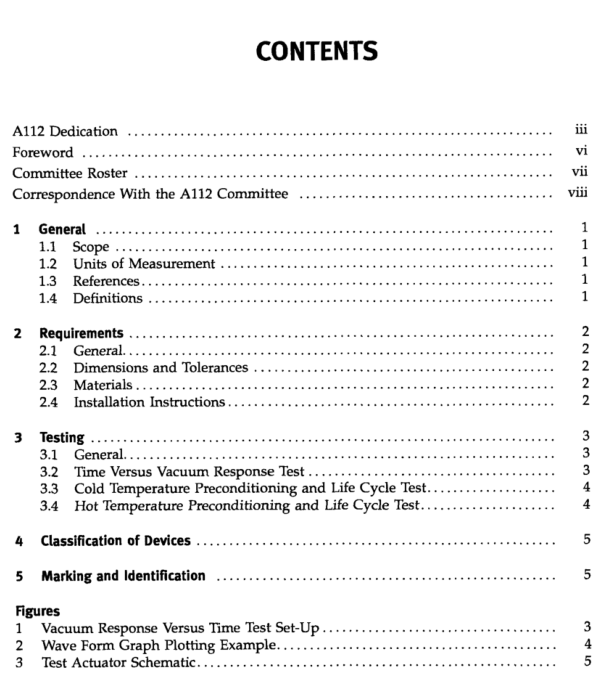ASME A112.19.17 pdf download

ASME A112.19.17 pdf download MANUFACTURED SAFETYVACUUM RELEASE SYSTEMS(8VRS) FOR RESIDENTIAL ANDCOMMERCIAL SWIMMING POOL,SPA, HOT TUB, AND WADINGPOOL SUCTION SYSTEMS
Safety Vacuum Release System: a system or device capableof providing vacuum release at a suction outlet causedby a high vacuum occurrence due to a suction outletflow blockage, by either venting the circulation systemto atmosphere, turning off the circulating pump, orreversing circulating flow. The device or system pro-vides vacuum release with or without suction fittingcover(s) in place.
submerged suction: a pool, spa,hot tub,wading pool,or similar appliance whose circulation system pumpsuction inlet or inlets are located below the static waterlevel in the appliance (flooded suction).
suction lift: a pool, spa, hot tub, wading pool, or similarappliance whose circulation system pump suction inletor inlets are located above the static water level in theappliance (nonflooded suction).
suction outlet: an appurtenance for conveying water intoa circulating system; i.e., a pump suction within a pool,spa, hot tub, wading pool, or similar appliance.
suction system: that portion of the circulation pipinglocated between the pool suction outlet and the inletside of the pump and usually includes the following:main outlet piping, skimmer piping vacuum piping,and surge tank piping.
2REQUIREMENTS2.1 General
2.1.1 Field-adjustable SVRS devices shall be pro-vided with a vacuum gauge graduated in h in.(13 mm)Hg increments with an accuracy of ±1 in.(25 mm) ofHg to provide continuous indication of system vac-uum level.
2.1.2 Where SVRSdevices are capable of field adjust-ment to site-specific hydraulic conditions, the means foreffecting adjustments shall be tamper resistant, so thatnonqualified personnel cannot make adjustments inad-vertently.
2.1.3 SVRS devices shall be designed for on-site ser-vicing and testing.
2.1.4sVRS devices shall either vent to atmosphere,or shut off the circulating pump, or reverse the circulat-ing system flow following a high vacuum occurrence.2.1.5sVRS devices shall latch or lock out in thevented, or safe position following a high vacuum occur-rence.
2.1.6 sVRs devices, following a high vacuum occur-rence, shall be manually reset without requiring specialtools, replacement parts, the introduction of special flu-ids, and/or gases before allowing normal suction levelsto resume.
2.1.8 sVRS devices shall fail in the open, vented, orsafe position in the event of spring, loading, or sensingmechanism failure.
2.2 Dimensions and Tolerances
2.2.1Where the sVRs device is provided with a Pvcend connection,the end connection shall conform toTables 1 and 2 of ASTM D 2466.
2.2.2Where the SvRs device is provided with anABS end connection, the end connection shall conformto ‘Tables 1 and 2 of ASTM D 2468.
2.2.3Where the svRs device is provided with athreaded end connection, the threaded end connectionshall conform to ASME B1.20.1.
2.3 Materials
2.3.1The materials used for constructing the deviceshall be in conformance with NSF-50 and UL 1081.2.3.2 When plastic materials are used,UV inhibitorsshall be added to the polymer mixture.
24lnstallation lnstructions
2.4.1Installation instructions, use and maintenanceinstructions,and adjustment instructions,and propertesting procedures shall be provided with each unit.2.4.2Installation instructions provided with the unitshall contain the following statements.
2.4.2.1sVRS devices shall only be installed inconjunction with an ASME A112.19.8 suction fitting, ora 12 in. × 12 in. (305 mm 305 mm) drain grate orlarger, or an approved channel drain system at eachsuction outlet or drain outlet.
2.4.2.2Check valves and hydrostatic valves shallnot be used in suction systems protected by sVRSdevices.
WARNING: The presence of a hydrostatic valve in the suctionpiping has been shown to prolong the high vacuum present atthe drain, even though the drain was protected by an SVRSdevice.
2.4.2.3All SvRs devices shall be factory set orfield adjusted to site-specific hydraulic conditions. Onceinstalled, the system shall be tested by simulating anentrapment event.









